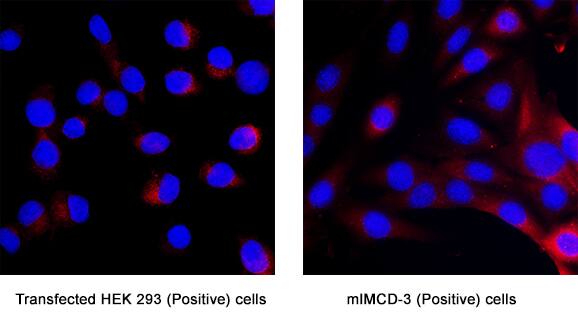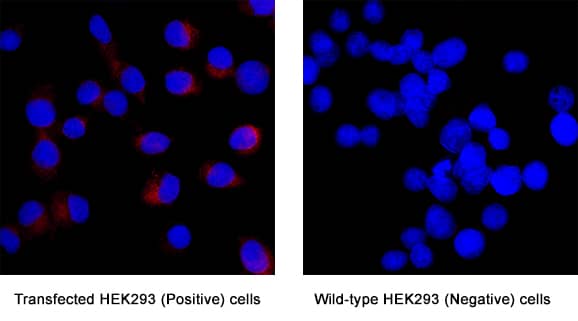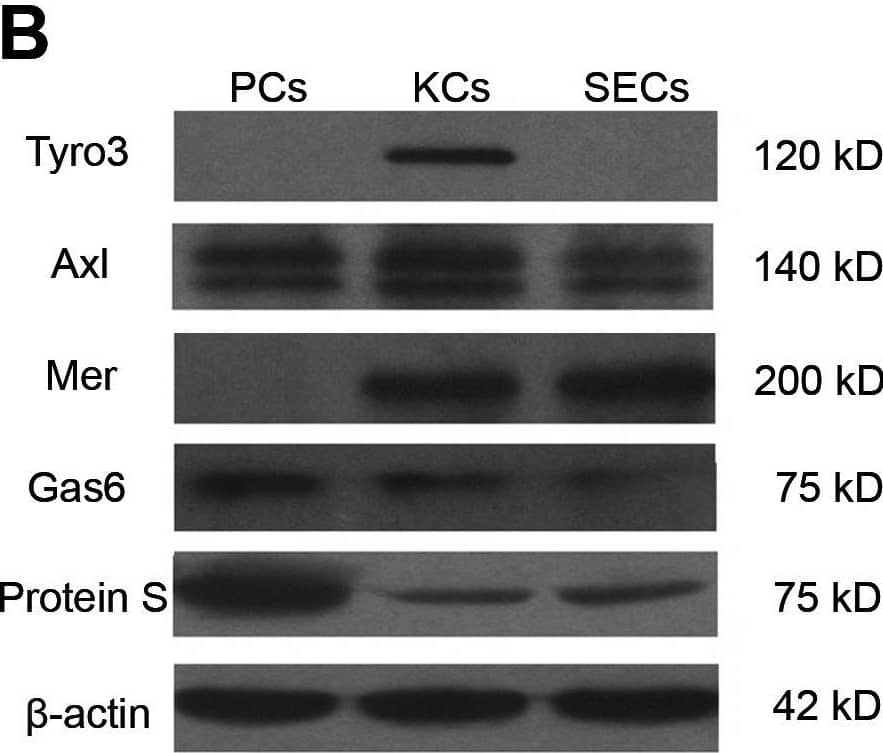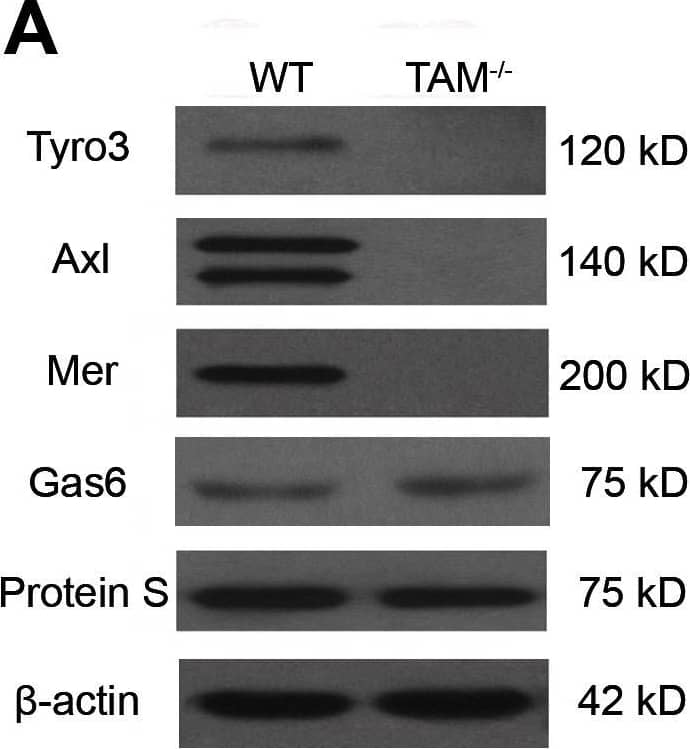Mouse Tyro3/Dtk Antibody
R&D Systems, part of Bio-Techne | Catalog # MAB759


Key Product Details
Species Reactivity
Validated:
Cited:
Applications
Validated:
Cited:
Label
Antibody Source
Product Specifications
Immunogen
Ala31-Ser418
Accession # P55144
Specificity
Clonality
Host
Isotype
Scientific Data Images for Mouse Tyro3/Dtk Antibody
Detection of Tyro3/Dtk in Transfected HEK 293 (positive) and mIMCD-3 (positive).
Tyro3/Dtk was detected in immersion fixed Transfected HEK293 human embryonic kidney cells (positive) and mIMCD-3 mouse epithelial cell line (positive) using Rat Anti-Mouse Tyro3/Dtk Monoclonal Antibody (Catalog # MAB759) at 25 µg/mL for 3 hours at room temperature. Cells were stained using the NorthernLights™ 557-conjugated Anti-Rat IgG Secondary Antibody (red; Catalog # NL013) and counterstained with DAPI (blue). Specific staining was localized to cytoplasm. View our protocol for Fluorescent ICC Staining of Cells on Coverslips.Detection of Tyro3/Dtk in Transfected HEK 293 (positive) and wild-type HEK 293 (negative) cells.
Tyro3/Dtk was detected in immersion fixed Transfected HEK293 human embryonic kidney cells (positive) and absent in wild-type HEK293 human embryonic kidney cells (negative) using Rat Anti-Mouse Tyro3/Dtk Monoclonal Antibody (Catalog # MAB759) at 25 µg/mL for 3 hours at room temperature. Cells were stained using the NorthernLights™ 557-conjugated Anti-Rat IgG Secondary Antibody (red; Catalog # NL013) and counterstained with DAPI (blue). Specific staining was localized to cytoplasm. View our protocol for Fluorescent ICC Staining of Cells on Coverslips.Detection of Mouse Dtk/TYRO3 by Western Blot
Expression of TAM RTKs, Gas6 and Protein S.(A) Western blot analyses of the liver lysates for the examination of TAM RTKs, Gas6 and Protein S. (B) Expression of TAM RTKs, Gas6 and Protein S in isolated liver cells: parenchymal cells (PCs), Kupffer cells(KCs) and sinusoidal endothelial cells (SECs). The primary cells were subjected to Western blotting. (C) Immunohistochemistry for the detection of TAM RTKs, Gas6 and Protein S. Arrowheads indicate PCs, and arrows indicate spindle-shaped sinusoidal cells corresponding to KCs and SECs. In negative controls (islets), sections were incubated with primary antibodies pre-incubated with an excess of blocking peptide. The livers of 15-week-old WT mice were used for the protein analyses. The images are representatives of at least three experiments. Scale bar = 20 µm. Image collected and cropped by CiteAb from the following open publication (https://pubmed.ncbi.nlm.nih.gov/23799121), licensed under a CC-BY license. Not internally tested by R&D Systems.Applications for Mouse Tyro3/Dtk Antibody
Immunocytochemistry
Sample: Immersion fixed Transfected HEK293 human embryonic kidney cells (positive), mIMCD-3 mouse epithelial cells (positive), and wild-type HEK293 human embryonic kidney cells (negative)
Western Blot
Sample: Recombinant Mouse Tyro3/Dtk Fc Chimera (Catalog # 759-DT)
Mouse Tyro3/Dtk Sandwich Immunoassay
Formulation, Preparation, and Storage
Purification
Reconstitution
Formulation
Shipping
Stability & Storage
- 12 months from date of receipt, -20 to -70 °C as supplied.
- 1 month, 2 to 8 °C under sterile conditions after reconstitution.
- 6 months, -20 to -70 °C under sterile conditions after reconstitution.
Background: Tyro3/Dtk
Axl (Ufo, Ark), Dtk (Sky, Tyro3, Rse, Brt) and Mer (human and mouse homologues of chicken c-Eyk) constitute a new receptor tyrosine kinase subfamily. The extracellular domain of these proteins contain two Ig-like motifs and two fibronectin type III motifs. This characteristic topology is also found in neural cell adhesion molecules and in receptor tyrosine phosphatases. All three receptors bind the vitamin K-dependent protein growth-arrest specific gene 6 (Gas6) which is structurally related to the anticoagulation factor protein S. The binding affinities for Gas6 is in the order of Axl > Dtk > Mer. Gas6 binding induces tyrosine phosphorylation and downstream signaling pathways that can lead to cell proliferation, migration, or the prevention of apoptosis. Dtk is widely expressed during embryonic development. In adults, Dtk is predominantly expressed in neurons in restricted regions of the brain.
References
- Nagata, K. et al. (1996) J. Biol. Chem. 22:30022.
- Crosier, K.E. and P.S Crosier (1997) Pathology 29:131.
Long Name
Alternate Names
Gene Symbol
UniProt
Additional Tyro3/Dtk Products
Product Documents for Mouse Tyro3/Dtk Antibody
Product Specific Notices for Mouse Tyro3/Dtk Antibody
For research use only


